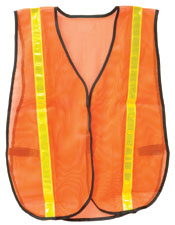Better Safe Than…
“I get the big picture,” says Steve Patterson, owner of Central Valley Builders Supply in Napa, Calif. “I can certainly say we are emphasizing safety.”
Several years ago, Central Valley was faced with workers comp rates that were rising at a fairly rapid and unsustainable pace, according to Patterson. “We had to take things into our own hands and control the costs,” he says.
The safety message is hard to miss at Central Valley. Yard employees wear bright orange T-shirts with “Safety Always” emblazoned across the back. Banners declare “Our Goal: No Accidents,” and any upfront personnel or visitors must wear an orange safety vest when walking through the yard.
Central Valley has made it pretty simple, Patterson explains, when it comes to safety meetings: they are held biweekly, companywide, on payday. As a result, employees associate payday with safety. They are required to read through a safety topic and sign off before getting paid.
Hammond Lumber in Belgrade, Maine, uses a similar technique. A companywide safety committee, which president Dan Hammond chairs, holds monthly meetings to discuss safe and unsafe situations. It reaches conclusions, then issues an internal memo to provide insight and instruction to employees, who must sign a statement attesting that they have read the memo.
Safety courses taught at Hammond range from the proper use of electrical cords to the potential dangers of being exposed to blood-borne pathogens, as well as first aid. The dealer uses fluorescent T-shirts and lime-green safety hats in its yards as well.
Although Hammond’s sales volume changes drastically between summer and winter, the company tries to avoid summer temp hiring and winter layoffs. As a result, Hammond does not have a lot of newcomers or out-of-practice returnees who are more prone to accidents. “There is a culture of peer pressure,” says Matt Masse, operations and purchasing chief at Hammond. “They cover each other’s back for being safe.”
But preaching safety is not necessarily about keeping workers comp rates down. “It’s our desire that people are there every day, working safely, and living and breathing it every day,” Patterson says. “Sometimes that’s hard to impress on people. We need them, we want to provide for their families. It’s a mutual relationship.”
For instance, employees don’t always recognize that if they are injured and forced out of work, they may not receive full compensation. As Patterson notes, “they won’t have enough money to put food on the table.”
Each Wednesday, Michael McGinnis, Central Valley’s safety, fleet, and properties manager, reviews safety “observations” that have been made by each location’s operations manager, who also serve as safety directors. Near misses are discussed, so “they don’t become accidents,” says McGinnis. If a near miss occurs–such as not using the horn on a forklift when exiting a warehouse or lifting materials incorrectly–it’s discussed with the individual.
Last May, Hancock Lumber of Casco, Maine, celebrated one month of no reported injuries among its 200 employees at its 13 locations, including three sawmills and eight retail yards. “We report everything,” says Greg Speed, who has served as Hancock’s safety director for the last 11 years. “We’ve gone three weeks before, but never a month. For us, it’s a really big deal.” To celebrate the occasion, Hancock grilled steaks at each of its locations.
Good deeds at Hammond don’t go unrecognized, either. Those who practice safety techniques get rewards, such as gift certificates. Similarly, Hammond Lumber gives out scratch-off lottery tickets to employees who are spotted working safely.
Central Valley is in talks to provide a steak dinner and a party to its safest location at year’s end, while Tindell’s typically gives out a safety award and gifts to the members of its safest location during the company’s annual Christmas/Safety breakfast.



